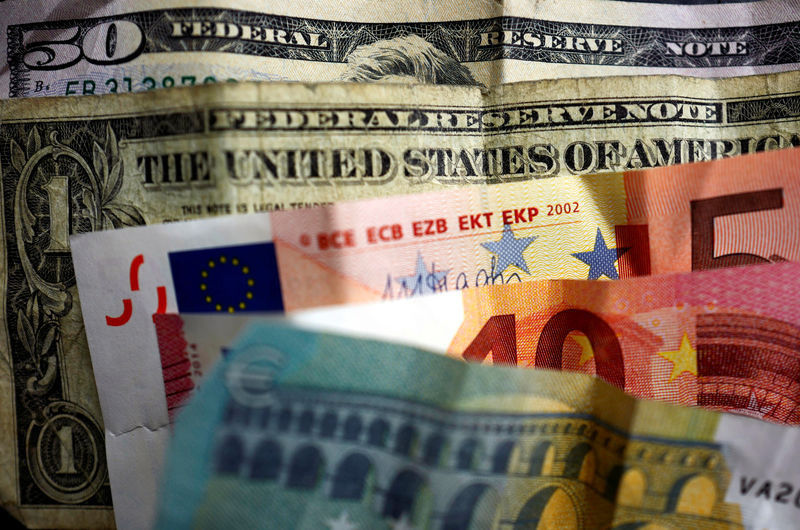Forex
Dollar retreats from highs as risk appetite improves; euro edges up after PMIs


© Reuters.
Investing.com – The U.S. dollar retreated from six-week highs in early European trade Wednesday amid rising risk appetite, while the euro struggled to push higher ahead of this week’s European Central Bank policy meeting.
At 04:00 ET (09:00 GMT), the Dollar Index, which tracks the greenback against a basket of six other currencies, traded 0.3% lower at 103.107, not far below the highest level since early December at 103.82, reached in the previous session.
Dollar retreats from highs
Positive corporate earnings, from streaming giant Netflix (NASDAQ:) in particular, have resulted in a boost to risk appetite Wednesday, causing the dollar to edge lower.
However, the greenback remained close to recent highs as strong inflation and labor market data saw traders largely scale back expectations for early interest rate cuts by the Fed.
Focus now turns to fourth-quarter data, due on Thursday, and Friday’s data – the Fed’s preferred inflation gauge. Any signs of resilience in economic growth and inflation give the Fed more impetus to keep rates higher for longer.
“We don’t have a strong bearish view on the dollar in the short-term, but yesterday’s moves did appear overdone in an environment where Fed funds futures still price in 130/140bp of cuts this year,” said analysts at ING, in a note.
The is widely expected to maintain rates at 23-year highs next week, but traders are still looking for the central bank to eventually begin trimming rates this year.
Euro struggles to gain after weak PMIs
In Europe, traded 0.1% higher at 1.0865, with the euro struggling to benefit from the positive risk sentiment after the release of data showing that Germany’s economic downturn worsened this month with both and activity contracting.
Germany’s Ifo institute downgraded its 2024 economic growth forecast on Wednesday, and now expects Europe’s largest economy to grow by 0.7% this year instead of 0.9% previously forecast in mid-December.
The meets on Thursday, and is virtually certain to keep rates steady at elevated levels. Investors will thus focus on the tone of the policy statement and President Christine Lagarde’s press conference.
That said, “a data-dependent ECB makes markets data-dependent, meaning upcoming releases on inflation and activity in the eurozone may well have a greater market impact than ECB members’ comments,” ING added.
traded 0.2% higher at 1.2712, ahead of the release of U.K. data for January, which is expected to show the U.K. economy remains in expansion territory as a whole.
Yen appreciates as yields rise
In Asia, fell 0.5% to 147.57, with the yen boosted by Japanese government bond yields rising to six-week highs after central bank chief said on Tuesday that the prospects of achieving the BOJ’s inflation target were gradually increasing.
traded 0.1% lower to 7.1661, with the yuan seeing some strength this week after Bloomberg reported that the Chinese government was planning a hefty support package for local stock markets.
Upgrade your investing with our groundbreaking, AI-powered InvestingPro+ stock picks. Use coupon INVESTPROPLUS24 to get a limited time discount on our Pro+ subscription plans. Click here to find out more, and don’t forget to use the discount code when checking out!

 Forex3 years ago
Forex3 years agoForex Today: the dollar is gaining strength amid gloomy sentiment at the start of the Fed’s week

 Forex3 years ago
Forex3 years agoUnbiased review of Pocket Option broker

 Forex3 years ago
Forex3 years agoDollar to pound sterling exchange rate today: Pound plummeted to its lowest since 1985

 Forex3 years ago
Forex3 years agoHow is the Australian dollar doing today?

 Cryptocurrency3 years ago
Cryptocurrency3 years agoWhat happened in the crypto market – current events today

 World3 years ago
World3 years agoWhy are modern video games an art form?

 Commodities3 years ago
Commodities3 years agoCopper continues to fall in price on expectations of lower demand in China

 Economy3 years ago
Economy3 years agoCrude oil tankers double in price due to EU anti-Russian sanctions





















